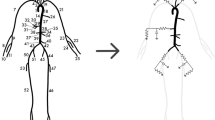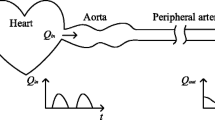Abstract
A new one-step computational procedure is presented for estimating the parameters of the nonlinear three-element windkessel model of the arterial system incorporating a pressure-dependent compliance. The data required are pulsatile aortic pressure and flow. The basic assumptions are a steadystate periodic regime and a purely elastic compliant element. By stating two conditions, zero mean flow and zero mean power in the compliant element, peripheral and characteristic resistances are determined through simple closed form formulas as functions of mean values of the square of aortic pressure, the square of aortic flow, and the product of aortic pressure with aortic flow. The pressure across as well as the flow through the compliant element can be then obtained so allowing the calculation of volume variation and compliance as functions of pressure. The feasibility of this method is studied by applying it to both simulated and experimental data relative to different circulatory conditions and comparing the results with those obtained by an iterative parameter optimization algorithm and with the actual values when available. The conclusion is that the proposed method appears to be effective in identifying the three-element windkessel even in the case of nonlinear compliance.
Similar content being viewed by others
References
Avanzolini, G., A. Cappello, and G. Gnudi. An efficient algorithm for estimating circulatory mechanical parameters by microcomputers. In: Proc. IEEE-EMBS 11th Int. Conf. New York: IEEE, 1989, pp. 1979–1981.
Avanzolini, G., A. Cappello, and G. Gnudi. Model selection and parameter estimation for aortic input impedance.Automedica 5:37–53, 1984.
Avanzolini, G., A. Cappello, and G. Gnudi. A comparative evaluation of models for the aortic input impedance. In: Proc. VI Medit. Conf. Med. Biol. Eng., July 1992, edited by M. Bracale and F. Denoth Capri, Italy: Area di Ricerca-CNR-Pisa, 1992, pp. 227–230.
Bergel, D. H. Static elastic properties of the arterial wall.J. Physiol. 156:445–457, 1961.
Burattini, R., and K. B. Campbell. Modified asymmetric T-tube model to infer arterial wave reflection at the aortic root.IEEE Trans. Biomed. Eng. 36:805–814, 1989.
Burattini, R., and G. Gnudi. Computer identification of models for the arterial tree input impedance.Med. Biol. Eng. Comput. 20:134–144, 1982.
Burattini, R., G. Gnudi, N. Westerhof, and S. Fioretti. Total systemic arterial compliance and aortic characteristic impedance in the dog as a function of pressure: A model based study.Comput. Biomed. Res. 20:154–165, 1987.
Cappello, A., and G. Gnudi. Analysis of the arterial pressure-volume curve in the three-element windkessel model. In: Proc. Int. Conf. Computers in Cardiology—London, Sept. 5–8, 1993. Los Alamitos, CA: IEEE Computer Society Press, 1993, pp. 385–388.
Deswysen, B., A. A. Charlier, and M. Gevers. Quantitative evaluation of the systemic arterial bed by parameter estimation of a simple model.Med. Biol. Eng. Comput. 18:153–166, 1980.
Dujardin, J. P. L., and D. N. Stone. Characteristic impedance of the proximal aorta determined in the time and frequency domain: A comparison.Med. Biol. Eng. Comput. 19:565–568, 1981.
Laxminarayan, S., P. Sipkema, and N. Westerhof. Characterization of the arterial system in the time domain.IEEE Trans. Biomed. Eng. 25:177–184, 1978.
Li, J. K. J., T. Cui, and G. M. Drzewiecki. A nonlinear model of the arterial system incorporating a pressure-dependent compliance.IEEE Trans. Biomed. Eng. 37:673–678, 1990.
Ling, S. C., and H. B. Atabek. A nonlinear analysis of pulsatile flow in arteries.J. Fluid Mech. 55:493–511, 1972.
Liu, Z., K. P. Brin, and F. C. P. Yin. Estimation of total arterial compliance: An improved method and evaluation of current methods.Am. J. Physiol. 251 (Heart Circ. Physiol. 20):H588-H600, 1986.
Lucas, C. L., B. R. Wilcox, and B. Ha. Comparison of time domain algorithms for estimating aortic characteristic impedance in humans.IEEE Trans. Biomed. Eng. 35:62–68, 1988.
Milnor, R. W. Hemodynamics, 2nd edition. Baltimore, MD: Williams & Wilkins, 1989, pp. 6–200.
Schoukens, J., and R. Pintelon. Identification of Linear Systems, a Practical Guideline to Accurate Modeling, Oxford: Pergamon Press, 1991, pp. 20–80.
Toy, S. M., J. Melbin, and A. Noordergraaf. Reduced models of arterial systems.IEEE Trans. Biomed. Eng. 32: 174–176, 1985.
Westerhof, N., G. Elzinga, and G. C. Van den Bos. Influence of central and peripheral changes on the hydraulic input impedance of the systemic arterial tree.Med. Biol. Eng. 710–723, 1973.
Author information
Authors and Affiliations
Rights and permissions
About this article
Cite this article
Cappello, A., Gnudi, G. & Lamberti, C. Identification of the three-element windkessel model incorporating a pressure-dependent compliance. Ann Biomed Eng 23, 164–177 (1995). https://doi.org/10.1007/BF02368323
Received:
Revised:
Accepted:
Issue Date:
DOI: https://doi.org/10.1007/BF02368323




